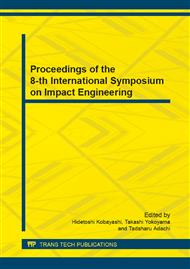p.67
p.73
p.80
p.86
p.92
p.97
p.104
p.110
p.116
Modelling of Formation of Adiabatic Shear Bands
Abstract:
Adiabatic shear bands are microstructural features that appear when metals, and some non-metals are subjected to impact loading at strain rates in excess of 103 s-1 and large strains. The formation of these bands is generally attributed to several competing mechanisms, among them is an initial strain hardening followed by adiabatic thermal softening that may lead to crack initiation within the bands. The authors have developed a model for formation of adiabatic shear bands in metallic materials as they are formed during testing using a torsional Hopkinson Bar. The model relies on a one dimensional analysis which predicts accurately the two steps of forming adiabatic shear bands in terms of strain hardening followed by thermal softening. In this current research, the model is extended to a two-dimensional analysis which would be suitable for application in either a two bar compression Split Hopkinson Bar or in a direct impact compression system developed by the author (Nabil Bassim) to produce high strain rates and large strains. The algorithm relies on applying the concept of dynamic recrystallization in order to determine the onset or initiation of the adiabatic shear bands.
Info:
Periodical:
Pages:
92-96
Citation:
Online since:
June 2014
Authors:
Price:
Сopyright:
© 2014 Trans Tech Publications Ltd. All Rights Reserved
Share:
Citation:


